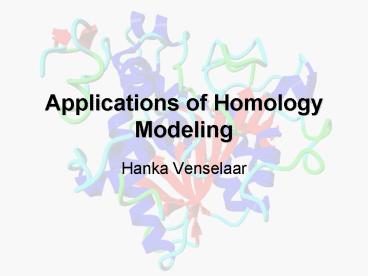Applications of Homology Modeling - PowerPoint PPT Presentation
1 / 35
Title:
Applications of Homology Modeling
Description:
iron/transferrin complex -Signaling and regulation of iron in bloodstream. ... Less interaction of the helix with the transferrin receptor. Seriousness of mutation ... – PowerPoint PPT presentation
Number of Views:24
Avg rating:3.0/5.0
Title: Applications of Homology Modeling
1
Applications of Homology Modeling
- Hanka Venselaar
2
This seminar.
- Homology Modeling
- What?
- Why?
- When?
- How?
- And a few real world examples.
3
EEC syndrome
Sequence
- MSQSTQTNEFLSPEVFQHIWDFLEQPICSVQPIDLNFVDEPSEDGATNKI
EISMDCIRMQDSDLSDMWPQYTNLGLLNSMDQQIQNGSSSTSPYNTDHAQ
NSVTAPSPYAQPSSTFDALSPSPAIPSNTDYPGPHSFDVSFQQSSTAKSA
TWTYSTELKKLYCQIAKTCPIQIKVMTPPPQGAVIRAMPVYKKAEHVTEV
VKRCPNHELSREFNEGQIAPPSHLIRVEGNSHAQYVEDPITGRQSVLVPY
EPPQVGTEFTTVLYNFMCNSSCVGGMNRRPILIIVTLETRDGQVLGRRCF
EARICACPGRDRKADEDSIRKQQVSDSTKNGDGTKRPFRQNTHGIQMTSI
KKRRSPDDELLYLPVRGRETYEMLLKIKESLELMQYLPQHTIETYRQQQQ
QQHQHLLQKQTSIQSPSSYGNSSPPLNKMNSMNKLPSVSQLINPQQRNAL
TPTTIPDGMGANIPMMGTHMPMAGDMNGLSPTQALPPPLSMPSTSHCTPP
PPYPTDCSIVSFLARLGCSSCLDYFTTQGLTTIYQIEHYSMDDLASLKIP
EQFRHAIWKGILDHRQLHEFSSPSHLLRTPSSASTVSVGSSETRGERVID
AVRFTLRQTISFPPRDEWNDFNFDMDARRNKQQRIKEEGE
EEC syndrome
4
Homology modeling in short
- Prediction of structure based upon a highly
similar structure
- 2 basic assumptions
- Structure defines function
- During evolution structures are more conserved
than sequence
Use one structure to predict another
5
Homology modeling
identity
O
residues
Actually, modelling is possible, but we cannot
get an alignment
Example by 80 residues ? 30 identity sufficient
6
Homology modeling in short
- Prediction of structure based upon a highly
similar structure
Model!
Copy backbone and conserved residues
Add sidechains, Molecular Dynamics simulation on
model
Known structure
7
The 8 steps of Homology modeling
8
1 Template recognition and initial alignment
9
1 Template recognition and initial alignment
- BLAST your sequence against PDB
- Best hit ? normally template
- Initial alignment ?
10
1 Template recognition and initial alignment
11
2 Alignment correction
- Functional residues ? conserved
- Use multiple sequence alignments
- Deletions ? shift gaps
Multipe sequence alignment
? Sequence with known structure ?Your sequence
Both are possible
12
2 Alignment correction
-A-V
F-D-
- Core residues ? conserved
- Use multiple sequence alignments
- Deletions in your sequence ? shift gaps
Known structure FDICRLPGSAEAV
Model FNVCRMP---EAI Model
FNVCR---MPEAI
? Correct alignment
13
2 Alignment correction
1 Template recognition and initial alignment
14
3 Backbone generation
- Making the model.
- Copy backbone of template to model
- Make deletions as discussed
- (Keep conserved residues)
15
2 Alignment correction
1 Template recognition and initial alignment
3 Backbone generation
16
4 Loop modeling
Known structure GVCMYIEA---LDKYACNC Your
sequence GECFMVKDLSNPSRYLCKC
Loop library, try different options
17
2 Alignment correction
1 Template recognition and initial alignment
3 Backbone generation
4 Loop modeling
18
5 Side-chain modeling
- Several options
- Libraries of preferred rotamers based upon
backbone conformation
19
2 Alignment correction
1 Template recognition and initial alignment
3 Backbone generation
4 Loop modeling
5 Sidechain modeling
20
6 Model optimization
- Molecular dynamics simulation
- Remove big errors
- Structure moves
to lowest
energy conformation
21
2 Alignment correction
1 Template recognition and initial alignment
3 Backbone generation
4 Loop modeling
5 Sidechain modeling
7 Model validation
6 Model optimization
22
7 Model Validation
- Second opinion by PDBreport /WHATIF
- Errors in active site? ? new alignment/ template
- No errors? ? Model!
23
2 Alignment correction
1 Template recognition and initial alignment
3 Backbone generation
4 Loop modeling
8 Iteration
8 Iteration
5 Sidechain modeling
8 Iteration
8 Iteration
7 Model validation
6 Model optimization
24
2 Alignment correction
1 Template recognition and initial alignment
3 Backbone generation
4 Loop modeling
8 Iteration
8 Iteration
5 Sidechain modeling
Model!
8 Iteration
8 Iteration
7 Model validation
6 Model optimization
25
8 steps of homology modeling
- 1 Template recognition and initial
- alignment
- 2 Alignment correction
- 3 Backbone generation
- 4 Loop modeling
- 5 Side-chain modeling
- 6 Model optimization
- 7 Model validation
- 8 Iteration
26
EEC syndrome
P63
- MSQSTQTNEFLSPEVFQHIWDFLEQPICSVQPIDLNFVDEPSEDGATNKI
EISMDCIRMQDSDLSDMWPQYTNLGLLNSMDQQIQNGSSSTSPYNTDHAQ
NSVTAPSPYAQPSSTFDALSPSPAIPSNTDYPGPHSFDVSFQQSSTAKSA
TWTYSTELKKLYCQIAKTCPIQIKVMTPPPQGAVIRAMPVYKKAEHVTEV
VKRCPNHELSREFNEGQIAPPSHLIRVEGNSHAQYVEDPITGRQSVLVPY
EPPQVGTEFTTVLYNFMCNSSCVGGMNRRPILIIVTLETRDGQVLGRRCF
EARICACPGRDRKADEDSIRKQQVSDSTKNGDGTKRPFRQNTHGIQMTSI
KKRRSPDDELLYLPVRGRETYEMLLKIKESLELMQYLPQHTIETYRQQQQ
QQHQHLLQKQTSIQSPSSYGNSSPPLNKMNSMNKLPSVSQLINPQQRNAL
TPTTIPDGMGANIPMMGTHMPMAGDMNGLSPTQALPPPLSMPSTSHCTPP
PPYPTDCSIVSFLARLGCSSCLDYFTTQGLTTIYQIEHYSMDDLASLKIP
EQFRHAIWKGILDHRQLHEFSSPSHLLRTPSSASTVSVGSSETRGERVID
AVRFTLRQTISFPPRDEWNDFNFDMDARRNKQQRIKEEGE
EEC syndrome
27
Arginine
- Loss of negative charge
- Loss of interaction with the DNA
Mutation R?S
Serine
28
Another real world example Mutation analysis HFE
29
Transferrin receptor (dimer) ?binds
iron/transferrin complex
HFE complex
-Signaling and regulation of iron in bloodstream.
-Expressed in liver and colon. -Mutations cause
iron deposition disease Hereditary
Hemachromatosis
HFE
ß2-microglobulin ? Facilitates trafficking of HFE
to the cellmembrane
30
Hereditary Hemachromatosis ?3 occuring mutations
- C280Y
- D41H
- L161P
L161P
D41H
C280Y
31
- Loss of cystein bridge
- Disturbing of ß2-microglobulin binding domain
- No trafficking to membrane
Mutation C260Y
32
- Introduction of additional negative charge
- Disturbing of hydrogen bridges
- Loss of stability in this area
Mutation H41D
33
- Loss hydrophobic interactions
- Major disturbance of the helix
- Less interaction of the helix with the
transferrin receptor
Mutation L161P
34
Seriousness of mutation
Seriousness of the disease
D41H L161P C260Y
D41H L161P C260Y
?Conclusion the seriousness of the mutation is
related to the seriousness of the disease and can
be explained by analyzing the mutations with the
3D structure.
35
To conclude.
- Homology Modeling
- What? Prediction of an unknown structure based on
an homologous and known structure - Why? To answer biological and medical questions
when the real structure is unknown - When? A template with enough identity must be
available - How? 8 Steps
- Real world examples mutations in EEC syndrome
and HFE can be explained































